- You may be looking for the 2005 episode or the 1963 episode.
Daleks were the armoured, mutated descendants of the Kaleds of the planet Skaro. They fought the Time Lords in the Last Great Time War, ending in the near-total destruction of both races. Intensely xenophobic and bent on universal domination, the Daleks were hated and feared throughout time and space. They were the oldest and most frequent foes of the Doctor, having faced him several times in every one of his incarnations.
Biology
Although the Daleks looked entirely robotic, they were in fact cybernetic organisms (or cyborgs), with a biological body encased in and supported by a protective outer shell of Dalekanium metal armour, armed and mobile. These were actually the Mark III travel machines designed to carry their mutant forms, and they were not true integrated biomechanoids. (AUDIO: The Four Doctors) In this respect, they were somewhat similar to a Cyberman; unlike them, however, the Daleks' bodies had mutated so drastically from their Kaled ancestors they had lost all humanoid appearance, save for one eye (see below). (TV: The Daleks, Evolution of the Daleks) The Daleks shared information using a sort of artificial telepathic network known as the Pathweb. (TV: Asylum of the Daleks)
Anatomy
Exterior
The Dalek casing, originally called a "Mark III travel machine", (TV: Genesis of the Daleks) could be separated into three sections.
- Top: The Dalek's means of vision and communication, a dome with a set of twin speaker 'lights' (referred to as luminosity dischargers). (PROSE: Prisoner of the Daleks) On the upper part of the sides and a telescope-like eyestalk in the middle. This was attached to the mid-section by a "neck".
- Midsection: On the Dalek's midsection, the gunstick and manipulator arm were attached. These provided the Dalek's means of offence and operating capabilities. In later models, the midsection was capable of swiveling.
- Bottom: The Dalek's means of mobility was a sturdy base with a skirt-like structure of plates studded with globes. This allowed movement and, in later models, flight.
Battle armour
The creatures inside their "machines" were almost always Kaled mutants, which the Seventh Doctor once described as "little green blobs in bonded polycarbide armour". (TV: Remembrance of the Daleks) According to one account, the creatues inside the Dalek casing were originally known as Dals. (TV: The Daleks)
Heavily mutated members of other species, including humans, also occupied the casings on occasion. (TV: Revelation of the Daleks, The Parting of the Ways, Asylum of the Daleks)
- Main article: Daleks of human origin
The interdependence of biological and mechanical components made the Daleks a type of cyborg. The Imperial Daleks created by Davros during the Imperial-Renegade Dalek Civil War were true cyborgs, surgically connected to their shells. (TV: Remembrance of the Daleks)
Externally, the Daleks resembled human-sized peppershakers, with a single mechanical eyestalk in a rotating dome, a gunstick and a manipulator arm. The casings were made of both polycarbide and dalekanium. (WC: Captain Jack's Monster Files)
The lower shell was covered with fifty-six hemispherical protrusions, which could serve as a self-destruct system. (TV: Dalek)
The Dalek creature had no visible vocal apparatus as such and their voices were electronic. Their most infamous battle-cry was "EX-TER-MIN-ATE!", each syllable screeched in a frantic-sounding, electronic scream (the last two syllables together). Other common utterances included "I (or "WE") OBEY!" to any command from a superior. Daleks also had communicators built into their shells to emit an alarm to summon other Daleks if the casing was opened from outside. (TV: Planet of the Daleks)
The Dalek's eyepiece was its most vulnerable spot – as there was no back-up system if this was obscured, damaged or destroyed – and impairing its vision often led to the Dalek panicking and firing its main weapon indiscriminately. (GAME: City of the Daleks) The Dalek casing also functioned as a fully-sealed environment suit, allowing travel through the vacuum of space or underwater without the need for additional life-support equipment. (TV: The Dalek Invasion of Earth, The Parting of the Ways) A Dalek's eyepiece could be connected to other Dalek vision centres. (GAME: City of the Daleks, TV: Asylum of the Daleks)
A Dalek was connected to its casing through a positronic link. The mutant itself accessed nutrient feeders and control mechanisms inside its internal chamber. (AUDIO: The Time of the Daleks)

A Dalek hovers above stairs. (TV: Remembrance of the Daleks)
Due to their gliding motion, earlier models of Dalek were baffled by stairs, which made them easy to overcome under the right circumstances. One time the Fourth Doctor and his companions escaped from Dalek pursuers by climbing into a ceiling duct. (TV: Destiny of the Daleks) Some models were able to hover, or fly under their own power like small spacecraft. (TV: Revelation of the Daleks, et al)
The armour of the Cult of Skaro had temporal shift capacity, seemingly the only users of such technology during the Battle of Canary Wharf. (TV: Doomsday, Daleks in Manhattan)
The power source of the Dalek casing also changed several times. During his first encounter with them on Skaro, the First Doctor learned that the casing was externally powered by static electricity transmitted through the metal floors of the Dalek City. Isolating a Dalek from the floor using a non-conductive material shut down the casing, although it was not immediately fatal to the occupant. (TV: The Daleks) The Daleks initially overcame this weakness by adding dishes to their casing to receive power, (TV: The Dalek Invasion of Earth), although even these were ultimately replaced by vertical rectangular slats around the midsection. (TV: The Chase)
By the beginning of the Last Great Time War, the Daleks had adapted their technology to use a type of energy apparently linked to the process of time travel. On more than one occasion, Daleks and their devices were seen to leech this energy from time-travellers to power themselves. (TV: Dalek, Doomsday)
Whatever the power source the Daleks used in the interim, it was (apparently uniquely) immune to being drained by the City of the Exxilons. Strangely, the Daleks retained motive power and the ability to speak even though their weaponry was shut down, which suggests the weapon systems had a separate power supply. The Third Doctor indicated that this was because the Daleks were psychokinetic, and the City unable to absorb psychic energy. Other references to the Daleks having psychic potential are scarce, but on the planet Kyrol, the Eighth Doctor discovered an enclave of humanised Daleks who had, through years of meditation, developed psychokinesis to a remarkable degree. (TV: Death to the Daleks, COMIC: Children of the Revolution)
The casing was booby-trapped, making even dead Daleks a dangerous foe. They were frequently equipped with virus transmitters which worked automatically. (PROSE: I am a Dalek) Furthermore, the armour contained an automated distress beacon which activated if disturbed. (TV: Planet of the Daleks)
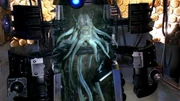
A Kaled mutant in Time War armour. (TV: Daleks in Manhattan)
Interior
The inner casing, in which the actual Dalek resided, also held a life support system and a battle-computer for strategic and tactical knowledge. The Dalek mutant operated the casings manually. Once removed, other life forms could pilot one if they could fit within. (TV: The Daleks)
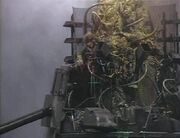
A Kaled mutant after the destruction of the Dalek shell. (TV: The Five Doctors)
Mutant
The interior mutant was, as the Seventh Doctor described it, a green or pinkish "blob." (TV: Remembrance of the Daleks) It was the brain of the Dalek and the true creature that hated everything not a Dalek. The "blobs" were usually genetically mutated Kaleds or, at times, other species captured by the Daleks. (TV: Genesis of the Daleks, Revelation of the Daleks, The Parting of the Ways, Asylum of the Daleks) They were depicted with multiple tentacular protrusions, a normal right eye and a left eye so reduced in size as to be easily missed - overall resembling what Lucie Miller described as "if someone threw up a squid dinner." (AUDIO: Blood of the Daleks) Despite their apparent lack of any motive capability, they were capable of defending themselves, as demonstrated when a Dalek attacked and killed a soldier. (TV: Resurrection of the Daleks)
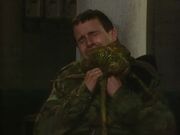
A Kaled mutant attacks a soldier. (TV: Resurrection of the Daleks)
While Daleks were typically small mutants, at least one member of the species, Dalek Sec, had extremely large tentacles and was pale green; he could even produce a sac-like membrane that appeared to come from his mouth (most likely a self-induced alteration in preparation for the final experiment). It was this membrane that he used to absorb Mr Diagoras and transform into a human-Dalek. (TV: Daleks in Manhattan) Before or during the Last Great Time War, the Daleks mutated even more, developing a large eye in roughly the centre of the lumpy flesh that comprised its body and tentacles. (TV: Dalek)
Vulnerabilities
Although they were nearly invulnerable, Daleks had several exploitable weaknesses. These changed and varied depending on the Dalek's type.
- Eyestalk susceptible to concentrated fire (TV: Resurrection of the Daleks, Remembrance of the Daleks, Dalek, The Parting of the Ways)
- Pride
- Impurities (TV: Revelation of the Daleks, AUDIO: Blood of the Daleks, TV: Evolution of the Daleks, AUDIO: Brotherhood of the Daleks)
- Arrogance
- Lack of imagination
- Movellan virus (TV: Resurrection of the Daleks)
- High explosives (TV: Planet of the Daleks, Remembrance of the Daleks)
- High-powered energy weapons (TV: Parting of the Ways, Journey's End)
- Bastic bullets (Necros Daleks only) (TV: Revelation of the Daleks)

A Dalek is exterminated. (TV: Revelation of the Daleks)
- Dalek gunsticks - Extermination and Disintegration (TV: Evil of the Daleks, Planet of the Daleks, The Five Doctors, Resurrection of the Daleks, Revelation of the Daleks, Remembrance of the Daleks, Evolution of the Daleks, Victory of the Daleks, PROSE: Legacy of the Daleks, COMIC: The Threat from Beneath)
- Extremely low temperatures (TV: Planet of the Daleks)
- Extreme heat and pressure
- Photon beams (COMIC: Doctor Who and the Dogs of Doom)
- Machine guns (PROSE: Legacy of the Daleks)
- Reliance on logic & machinery (TV: Destiny of the Daleks)
- Dinosaurs (COMIC: The Planet of the Daleks)
- Time Vortex (AUDIO: The Time of the Daleks)
- Metallic bats upgraded by the Hand of Omega into energy maces (TV: Remembrance of the Daleks)
- Overloading (TV: The Power of the Daleks, Asylum of the Daleks)
- Rocks in the path (Original Daleks only) (TV: The Daleks' Master Plan)
- Intense sonic beams (TV: Revelation of the Daleks)
- Similar Dalekanium weapons. (GAME: Destiny of the Doctors)
- Judged as threats to their own kind by other Daleks (TV: Revelation of the Daleks, Remembrance of the Daleks, Evolution of the Daleks, Asylum of the Daleks)
- Profound insanity (TV: The Stolen Earth, Journey's End, Asylum of the Daleks)
- Hatred towards self-impurity (TV: Dalek, The Parting of the Ways, Daleks in Manhattan, Evolution of the Daleks)
- Conflicting ideologies with other Daleks (TV: Revelation of the Daleks, Remembrance of the Daleks, Daleks in Manhattan, Evolution of the Daleks, Journey's End, Victory of the Daleks)
- Memory erasure by hacking into Pathweb and deleting information (TV: Asylum of the Daleks)
History
Based on the Fifth Doctor's definition of a generation as twenty-five years, (TV: Four to Doomsday) Dalek history spanned a thousand generations, 25,000 years. (TV: Genesis of the Daleks) This is presumably linearly-speaking without taking time travel into account.
Please help by adding some more information.
Origin of name
Davros found a prophecy in the forbidden Book of Predictions, written in the extinct language of the Dals, which stated "...and on that day, men will become as gods." In the original language, the final word was pronounced "Dal-ek." (AUDIO: Guilt) Davros heard the word in the proposed "Dalek Solution", presented to him by assistant Shan; he soon stole her idea, and adapted it into what would become the creation of the Daleks. (AUDIO: Davros)
According to one account, "Dalek" was an anagram of "Kaled", the race from which the Daleks were genetically engineered. Ronson, a member of the Scientific Elite under the command of Davros, mentioned that the word "Dalek" had never been heard before the Fourth Doctor used it and then, hours later, Davros himself uttered it. (TV: Genesis of the Daleks)
Encountering the Doctor
There were several conflicting accounts over how the Daleks came to be. (TV: The Daleks, Genesis of the Daleks, COMIC: Genesis of Evil)
- Main article: Creation of the Daleks
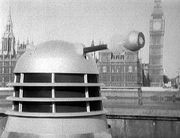
A Dalek patrols London. (TV: The Dalek Invasion of Earth)
At one point, the Daleks were stranded in their city, where they found that the Thals had also survived what was known as the neutronic war. After discovering they became dependent on the background radiation to the point of the anti-radiation meds Susan Foreman gave them being lethal to them, the Daleks attempted to set off atomic weapons which would have left them as the only living species on Skaro. The First Doctor and his companions led a Thal assault and deactivated their power. (TV: The Daleks)
However, the Daleks survived and, being led by the Dalek Emperor and the Dalek Council, forged an interstellar (and later intergalactic) Dalek Empire. (TV: The Daleks' Master Plan)
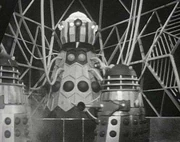
The Emperor's Personal Guard try to protect him. (TV: The Evil of the Daleks)
Daleks led by the Emperor began working on time travel technology in conjunction with Theodore Maxtible. The Daleks wanted humanised Daleks, so they forced the Second Doctor to implant the Human Factor into three Daleks. This would also identify the Dalek Factor, which they would spread through Earth's history. However, the Second Doctor encouraged the three humanised Daleks, Alpha, Beta and Omega, to defend themselves. Fearful of the implications, the Emperor ordered many Daleks through an archway that would reimplant the Dalek Factor. However, the Doctor switched factors so that all Daleks through the archway were humanised. Dalek Civil War broke out on Skaro apparently ending the Daleks. (TV: The Evil of the Daleks)
One of the factory ships that escaped the destruction on Skaro crashed on Vulcan. It lay there for three hundred years until Lesterson penetrated the capsule. The Daleks claimed to be the colonists' servants. The Daleks took advantage of the colonists' naive trust to establish a reproduction plant - on a conveyor belt system - with which to increase their numbers. The Second Doctor eventually destroyed the Daleks by turning the colony's power source against them. (TV: The Power of the Daleks)
Over the course of their history, the Daleks developed time travel (TV: The Chase), an interstellar (and later intergalactic) Dalek Empire (TV: The Daleks' Master Plan) and factory ships for conquest. (TV: The Power of the Daleks) The radio dishes which had originally been required to allow them to travel on surfaces without a static charge (TV: The Dalek Invasion of Earth) also vanished, enabling Daleks to move under their own power.
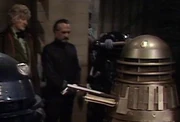
The Daleks order the Doctor's extermination. (TV: Frontier in Space)
The Daleks allied with the Master to undermime the Earth and Draconian Empires and set them against each other and then take over with a huge army assembled on Spiridon. (TV: Frontier in Space) Despite the Master's failure to cause war, the army was prepared and the Daleks looked at invisibility caused by Spiridon's inhabitants. The army was frozen by the Third Doctor and the Thals (TV: Planet of the Daleks) Once the Earth and Draconian Empires learned it was the Daleks disturbing the peace, war was declared on the Dalek Empire.
After decades of fighting, the Daleks found they were losing. They tried to use the Arkheon Threshold, a rift in time above a planet they had destroyed decades earlier, planning to use the rift to wipe out humanity throughout time so the human race never existed. They used human prisoners to dig through the crust of the planet to reach the Threshold. The Tenth Doctor joined forces with a crew of Dalek Bounty Hunters on board the Wayfarer. About the same time, the people of the planet Auros learned of an approaching Dalek fleet. The population fled before the Daleks arrived. The Daleks waited for the refugee fleet to come to them and the Dalek Inquisitor General, Dalek X, ordered the citizens sent to work in the Arkheon mines. The crew and the Doctor were taken prisoner on Arkheon and the Doctor admitted who he was. Dalek X arrived to subject the Doctor to torture and extract Bowman's brain to learn how to bypass Earth's defence systems.
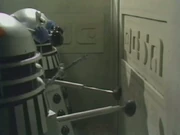
Weakened Daleks on Exxilon. (TV: Death to the Daleks)
The Doctor explained that the Daleks did not have the technology to use the Threshold but Dalek X thought the Doctor's TARDIS would allow their plan to succeed. The Doctor took Dalek X to Hurala, using the TARDIS as a lure, where Bowman, Koral and he escaped due to Cuttin' Edge attacking a Dalek and being exterminated. The Doctor detonated the abandoned fuelling station on Hurala, destroying all the Daleks as well as Dalek X's flagship, the Exterminator. The loss put a huge dent in the Dalek war machine. Earth pushed back their fleet and the Dalek Empire surrendered shortly after. Dalek X was knocked down a gantry and survived the explosion, though was badly damaged and unable to escape. (PROSE: Prisoner of the Daleks)
The Daleks finally catch the Doctor.
The Daleks formed an alliance with several species and Mavic Chen, who supplied them with an emm of Taranium,which was vital to the Time Destructor. The First Doctor escaped with the Taranium. The Daleks pursued him until he apparently surrendered it to them. This was a fake so a Dalek task force pursued him and his Companions through time until the core was recovered in Ancient Egypt. The Doctor activated the Time Destructor which destroyed the Daleks. (TV: The Daleks' Master Plan)

Bomb-laden Daleks on the march.
The Daleks got involved in a war with the Movellans which resulted in a stalemate: each side's purely logical battle computer keeping them in deadlock. To this end, the Daleks returned to Skaro to find Davros so his biological mind could reprogram their battle computers to win the war. However, the Fourth Doctor defeated them and the Movellans and Davros was taken by the Daleks' former slaves to stand trial. (TV: Destiny of the Daleks) The war continued for 90 years, until the Movellans developed a Movellan virus to defeat the Daleks. (TV: Resurrection of the Daleks)
War between the Imperials and Renegades
Afterwards, a detachment of Daleks led by a Supreme Dalek went to free their creator to find a cure for the virus. They also used a time corridor and and a Dalek Duplicate called Stien to trap the Fifth Doctor to duplicate him and his Companions to assassinate the Time Lord High Council. However, the Doctor broke free of duplication and turned Stien to his Cause. Meanwhile Davros turned several Dalek Troopers and two Daleks to his cause but the Supremes Daleks destroyed the rebels. Both Davros and the Doctor unleashed the virus and the Dalek ship was destroyed by Stien. (TV: Resurrection of the Daleks)
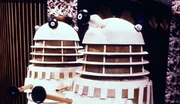
Daleks from Necros (TV: Revelation of the Daleks)
Davros escaped to Necros and began to turn intelligent cryogenically frozen people into Imperial Daleks to conquer the universe. However, Takis called the Renegade Daleks to take Davros to stand trial. The Renegades fought their way past the Imperials to take Davros. He tried to get them to take the Sixth Doctor, but they didn't recognise him. The Renegades' attempt to recondition the Imperials failed because of the Imperials' destruction by the Doctor and Orcini. (TV: Revelation of the Daleks)
En route to Skaro, the ship carrying Davros crashed on the planet Lethe. Davros was rescued. He set himself up as 'Professor Vaso' and attempted to create a new machine, a Juggernaut based on a Mechanoid design.
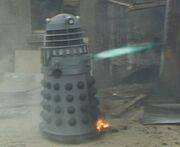
A Renegade Dalek attacks. (TV: Remembrance of the Daleks)
Lethe's atmosphere prevented the Supreme Dalek retrieving Davros directly, but its forces intercepted the Sixth Doctor's TARDIS, forcing him to serve as an agent of the Daleks and stop Davros' researches and manipulations. The Doctor discovered two of Davros' Necros Daleks had survived the crash, but were destroyed following Davros' final gambit on the colony and the Supreme Dalek's intervention. (AUDIO: The Juggernauts)
While on Skaro, the Sixth Doctor rescued Davros just before the Daleks carried out their sentence of death. The Doctor took Davros to Spiridon, where he could lick his wounds and bide his time. The Doctor intended to lay the groundwork for a Dalek civil war and spoke to Davros of his future destiny as Emperor Dalek.
When the Renegades led by the Supreme Dalek landed on Spiridon with the Seventh Doctor, Davros set his Imperial Daleks against them, along with a Special Weapons Dalek. The Supreme Dalek died. The Imperials then took over Skaro. (COMIC: Emperor of the Daleks!)
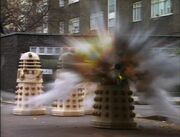
Imperial Daleks destroyed while battling Renegade Daleks. (TV: Remembrance of the Daleks)
The Imperial and Renegade Daleks both headed to Earth in 1963 to claim the Hand of Omega. The Imperials controlled H. Parson, while the Renegades used Judith Winters as their battle computer and "allied" with the Association. The two faction waged a lengthy battle at Shoreditch. Aided by the Special Weapons Dalek, the Imperial Daleks won, almost wiping out the Renegades aside from the Supreme. The Imperial Daleks took the Hand of Omega, as the Seventh Doctor had planned all along. Davros (as "Emperor" of the Imperials) plotted to make the sun of the Daleks' homeworld Skaro go supernova, giving the Daleks the power of unlimited time travel. In the Imperial Daleks' time zone, he did so. This action, however, destroyed the planet and the Imperial fleet. On Earth, the Doctor talked the last Renegade Dalek, the black Supreme Dalek, into self-destructing. (TV: Remembrance of the Daleks)
A New empire
The events of Dalek Empire need to be added
The Renegades survived this battle and began calling themselves Imperials. One account states that Davros' escape pod was acquired by a garbage ship, the Quetzel, which the Eighth Doctor and Sam Jones also ended up on. A group of Thals arrived, with the intention of using Davros to effectively turn them into Daleks so they could fight the Daleks better. A Dalek force arrived and took the Quetzel to a planet called Skaro. The Dalek Prime claimed that this was the original Skaro, and that the planet the Doctor had destroyed was a decoy called Antalin. The Dalek Prime knew that some of its own Daleks were loyal to Davros and put Davros on trial to flush them out. A battle ensued and the Dalek Prime emerged victorious. Davros was apparently executed but may have been teleported to safety by a loyal Spider Dalek. (PROSE: War of the Daleks)
Another account states that Davros' escape pod entered the time vortex and was found by a Nekkistani ship. The Eighth Doctor, Samson Griffin and Gemma Griffin found the Nekkistani ship in the vortex and the Griffins boarded the ship to investigate. Davros exacted his revenge by sending them back to Earth, wiping the Doctor's memory of them and operating on the TARDIS. Samson was sent home and Gemma became part of the "resistance" to the new race of Daleks Davros made on Earth. They conquered the planet, leaving only the area where Samson lived free from Dalek control. When the Doctor, Charley Pollard and C'rizz returned from the Divergent Universe, Davros was waiting for them. Davros' mind had become fractured between his own personality and that of "the Emperor". A series of events led to the Doctor actually giving the Daleks their Emperor and letting them leave Earth. Davros left Earth with his Daleks, the Emperor personality dominant. (AUDIO: Terror Firma)
The Time War
- Main article: Last Great Time War
The Last Great Time War was known as the "final battle" between the Time Lords and the Daleks. The Doctor was responsible for "burning" not only ten million Dalek ships, but every Time Lord apart from himself, (TV: Dalek) and at least the War Master. (TV: Utopia) The Doctor said this event happened in "one second". (TV: Dalek)
Surviving the Time War
Please help by adding some more information.
The Ninth Doctor incorrectly assumed that "the entire Dalek race" was "wiped out" apart from a lone Dalek that fell through time into the Ascension Islands. (TV: Dalek) Other survivors of the Time War included the Dalek Emperor (TV: The Parting of the Ways), the Cult of Skaro and a group of prisoners inside the Genesis Ark. (TV: Doomsday)
Society and culture
The Daleks were known to write poetry (PROSE: The Also People), and some of the more elaborate Dalek battlecries had an almost poetic quality about them (for example, "Advance and Attack! Attack and Destroy! Destroy and Rejoice!" (TV: The Chase) and repetition of words such as "Predict! Predict! Predict!" (TV: The Parting of the Ways) In an alternate reality, the Daleks showed a fondness for the works of William Shakespeare. (AUDIO: The Time of the Daleks)
The Daleks were a warlike race who waged war across whole civilisations and races all over the universe. (TV: The Daleks, Doomsday) When the Eleventh Doctor was on the Dalek Asylum he considered the Daleks the most advanced warrior race in the universe. (TV: Asylum of the Daleks)
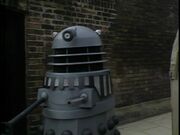
Due to their frequent defeats by the Doctor, he became a legendary figure in Dalek culture and mythology. They had standing orders to capture or exterminate the Doctor on sight, and were occasionally able to identify him despite his regenerations. The Daleks knew the Doctor as the "Ka Faraq Gatri", (which meant the "Bringer of Darkness" or "Destroyer of Worlds"). (COMIC: Bringer of Darkness) The Ninth Doctor claimed that the Daleks also called him "the Oncoming Storm". (TV: The Parting of the Ways)
The Doctor was also referred to as the Predator of the Daleks. Shortly before the destruction of the Dalek Asylum, Oswin erased all knowledge of the Doctor from every Dalek's memory. (TV: Asylum of the Daleks)
Psychology
Daleks had little individual personality and a strict hierarchy. They were conditioned to obey a superior's orders without question, even if these orders resulted in pain or death. (AUDIO: The Curse of Davros) The most fundamental feature of Dalek culture and psychology was an unquestioned belief in the superiority of the Daleks. Other species were either to be exterminated or enslaved, and then exterminated when no longer necessary. The default directive of a Dalek was to destroy all non-Dalek life forms.
The First Doctor meets the Daleks on Skaro. (TV: The Daleks)
Daleks even regarded "deviant" Daleks as their enemies and worthy of destruction. The civil war between the Renegade and Imperial Daleks was an example of this: Each faction considered the other a perversion despite the relatively minor differences. (TV: Remembrance of the Daleks) This belief also meant that Daleks were intolerant of such "contamination" even within themselves. (TV: Dalek, The Parting of the Ways, Evolution of the Daleks, AUDIO: The Mutant Phase) Despite this, Daleks felt offended by exterminating their own "divine hatred", and deviant Daleks would sometimes instead be sent to the Dalek Asylum, should their hatred be deemed pure enough. (TV: Asylum of the Daleks)
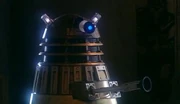
Another result of this superiority complex was their complete ruthlessness. This was due to genetic modifications made to the original Kaled mutants by Davros. It was because of this that it was nearly impossible to negotiate or reason with a Dalek, and it was this single-mindedness that made them so dangerous.
Their reliance on logic and machinery was a weakness, albeit one that they recognised. Daleks considered illogical actions impossible. (TV: Destiny of the Daleks) They transferred emotions from other life-forms twice, in one case humans, having refined the Human Factor with the help from the Second Doctor to create humanised Daleks. (TV: The Evil of the Daleks) In another instance, they refined savagery, hatred and cunning from other life forms. (COMIC: Doctor Who and the Dogs of Doom)
One unintentionally humanised Dalek occurred after it used Rose Tyler's DNA to regenerate after sustaining injuries, involuntarily developing positive feelings. Its traditional Dalek psychology remained, however, and it ultimately self-destructed in disgust.
The emotional capacity of Daleks was limited to largely negative emotions (hate being chief among them), as "human" emotions such as compassion and sentimentality were considered by them to be weaknesses. However, they were capable of comprehending these emotions, and often used them to exploit their enemies. A prime example occurred with the lone Dalek in Henry van Statten's vault; while talking with the Ninth Doctor, the Dalek chose its words carefully, hoping to goad the Time Lord into initiating a physical attack on the chained mutant. Later, the Dalek played on an unwitting Rose Tyler's feelings of pity and compassion, leading her to touch its battered casing and restore energy to the near-dead Dalek. (TV: Dalek)
Additionally, the Daleks used the greed of Theodore Maxtible to make him their ally. However, Daleks never formed permanent alliances; once their allies outlived their usefulness, they were usually exterminated on the spot. (TV: The Evil of the Daleks)
Religion
As noted above, the Daleks created by the manipulation and mutation of human genetic material by a demented Dalek Emperor were religious fanatics. They worshipped the Emperor as their god. Normal Daleks had no religion, other than their fanatic belief in their own supremacy. (TV: The Parting of the Ways)
Legal system
Although the Daleks had no regard for due process and Galactic Law, there were at least two occasions on which they took enemies back to Skaro for a "trial" rather than killing them on the spot; the first was their creator Davros (TV: Revelation of the Daleks) and the second was the renegade Time Lord known as the Master. (TV: Doctor Who)
Accounts differ as to whether the retrieval of Davros was for a 'trial' in the criminal sense, (COMIC: Emperor of the Daleks!) or a test to see if he was in fact worthy of becoming the supreme leader of the race. (AUDIO: I, Davros)
Dalek hierarchy
- Main article: Dalek hierarchy
Although they saw their entire species as superior, the Daleks had a hierarchical system. This included a wide range of ranks bestowed upon selected Daleks. (TV: The Daleks, The Dalek Invasion of Earth', The Evil of the Daleks, Victory of the Daleks)
Dalek writings
- Main article: Dalek writing
Daleks used inscriptions as recognition codes. (TV: Doomsday) They were able to read human numerals and words, even using them upon occasion. (TV: Planet of the Daleks)
Cultural effect
The Daleks had a devastating effect on the races and individuals that encountered them. For the most part they epitomised fear and danger, especially for the Doctor; upon arriving in 1966 and seeing the Post Office Tower that contained WOTAN, the First Doctor remarked to Dodo he had felt like that when the Daleks were near. (TV: The War Machines) The Second Doctor used his encounters with them to warn Zoe Heriot of what she might encounter. (TV: The Wheel in Space) The Second Doctor also later used a mental projection of a Dalek to show the Time Lords of his enemies. (TV: The War Games) A Dalek was one of many fears that assaulted the Third Doctor in the Keller Machine. (TV: The Mind of Evil) When he approached his fourth regeneration, a vision of a Dalek came to the Fourth Doctor. (TV: Logopolis) An amnesic Eighth Doctor once looked suspiciously at a pepper pot, which was similar to a Dalek's shape. (PROSE: The City of the Dead) Their power over the Doctor continued through his personality when he used a Chameleon Arch; his human self, John Smith, sketched a Dalek within his Journal of Impossible Things. (TV: Human Nature) Daleks were among the creatures in the Atraxi's files of races that invaded Earth. (TV: The Eleventh Hour)
Their danger was on occasion negligible compared to a greater threat; when speaking of his fellow Time Lords at his trial, the Sixth Doctor stated that "In all my travellings throughout the universe, I have battled against evil, against power-mad conspirators. I should have stayed here! The oldest civilisation, decadent, degenerate and rotten to the core! Power-mad conspirators, Daleks, Sontarans, Cybermen - they're still in the nursery compared to us! Ten million years of absolute power! That's what it takes to be really corrupt!" (TV: The Ultimate Foe) When Rassilon threatened to break the Time-lock on the Last Great Time War the Tenth Doctor warned the Saxon Master, that "not just the Daleks" would be unleashed if it were broken. (TV: The End of Time)
The Daleks' impact on those humans who encountered them had different effects on their psyches. They appeared in dreams or visions; Ace associated the Daleks with Nazis; a Dalek with a swastika chased her, chanting "Heil Doktor" following her time in an alternate universe populated by Nazis. (PROSE: Timewyrm: Exodus) She later called the Daleks "the catch" to travelling with the Doctor. (AUDIO: Enemy of the Daleks) To Bernice Summerfield a Dalek appeared, also in a dream, along side several other races such as Sontarans and Cybermen in which the nature of evil was dissected. (PROSE: The Also People) Sam Jones, on awakening from unconsciousness exclaimed, "Anyone get the number of that Dalek?". (PROSE: The Taint) Alternatively, encounters with the Daleks took a certain pride of place for some individuals. Rose Tyler and Sarah Jane Smith compared their experiences encountering Daleks (and, in Rose's case, the Dalek Emperor) upon meeting. (TV: School Reunion) During the 2009 invasion, upon hearing the transmission of "EXTERMINATE", Sarah Jane and Jack Harkness reacted with undiluted terror, crying and holding their loved ones close. (TV: The Stolen Earth)
Dalek technology
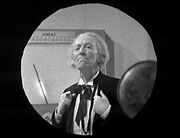
A Dalek's view through its eyepiece. (TV: The Dalek Invasion of Earth)
The key item of Dalek technology was the casing, derived from the Mark III Travel Machines built by Davros. The casings of Davros' Imperial Daleks were made out of bonded polycarbide. (TV: Remembrance of the Daleks)
The eyestalk of the casing bestowed superior vision to the Dalek creature. The plunger-shaped attachment functioned as a flexible and adaptable limb. (TV: Dalek) Dalek gunsticks could kill almost any sentient being (TV: The Daleks, et al) and could paralyse their victims temporarily (TV: "The Survivors") or permanently. [additional sources needed]
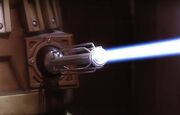
On the Dalek Asylum there was a nanocloud virus that physically transformed organisms into Dalek puppets which removed all emotion except anger and hatred. (TV: Asylum of the Daleks)
The Dalek's gunstick evolved alongside other aspects of Dalek technology. When the First Doctor met them in the Dalek City, the gunstick seemed to have the same qualities as a human gun. Daleks could also change the effects of their guns' energy projectiles; at the lowest level, they would merely temporarily disable an individual in the area the projectiles struck. (TV: The Daleks) The highest setting on a Dalek gunstick would reduce a human to atoms, but the Daleks rarely used that. Instead, they made certain to dial their guns down to the lowest possible setting that would kill a person - that way, Daleks would ensure that all of their victims died as slowly and painfully as possible. (PROSE: Prisoner of the Daleks)
On the surface of Skaro, within the confines of the Dalek City, the machines ran on static electricity fed from the city floor. They were incapacitated if removed from the floor. The casing technology changed over the years. The first Daleks to emerge from the bunker in which they had been entombed built a city and power from those. (TV: The Daleks) Those occupying Earth during the their 22nd century invasion had dishes on their backs. (TV: The Dalek Invasion of Earth) Later models of Dalek casing had internal power supplies, and even repulsor systems[additional sources needed] that allowed them to hover (TV: Remembrance of the Daleks, Dalek) and fly. (TV: The Parting of the Ways, Army of Ghosts/Doomsday, The Stolen Earth/Journey's End)
Throughout time and space, there were many Dalek variants that sported different casings. A Dalek's ability depended on what features its casing offered. (TV: The Daleks, The Evil of the Daleks) The default manipulator arm could be replaced with the likes of flamethrowers and seismic detectors. (TV: The Chase, The Daleks' Master Plan)
By the era of the Last Great Time War, Daleks had force-fields. Whereas previous versions of Daleks could be destroyed by a well-placed bastic bullet, such bullets could not get close to these Daleks' casings. (TV: Dalek, The Parting of the Ways) However, they could be penetrated by their own weaponry, and variations thereof. (TV: Evolution of the Daleks, Victory of the Daleks) They not only could hover, but travel independently through space. (TV: The Parting of the Ways) These Daleks could use the DNA of a time traveller to regenerate their bodies just by virtue of the traveller touching the casing. (TV: Dalek)
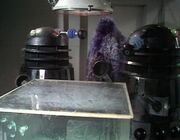
The Daleks admire their bioweapon. (TV: Planet of the Daleks)
The Daleks were also experts in biological warfare, and used (or attempted to use) biological weapons on several occasions. (TV: The Dalek Invasion of Earth, Planet of the Daleks, Death to the Daleks)
Dalek travel technology varied over time. Dalek spaceships were (almost) consistently designed in a saucer shape, (TV: Bad Wolf / The Parting of the Ways, The Stolen Earth / Journey's End, Victory of the Daleks) and hoverbouts allowed individual Daleks to travel without using their own power. (AUDIO: Fugitives)They were also able to hack into virtual reality systems, creating attack ships in Puterspace, although they were not particuarly good at it. (PROSE: Love and War)
The Daleks also developed time travel capabilities, usually in the form of time corridors which allowed limited transport between one era and another. (TV: Resurrection of the Daleks) The Daleks also developed their own kind of time machine of similar capacities to the Doctor's TARDIS; though they could not change shape, they were also dimensionally transcendental. (TV: The Chase, The Daleks' Master Plan) Members of the Cult of Skaro could initiate 'emergency temporal shifts', which acted as teleports through time and space to let the Dalek escape a threat. (TV: Doomsday, TV: Daleks in Manhattan, The Stolen Earth)
Dalek weaponry
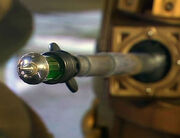
A Dalek syringe attachment (TV: Daleks in Manhattan)
- Main article: Dalek weaponry
The Dalek gunstick and manipulator arm could be re-purposed depending on what task was likely to face a specific individual, or removed altogether to render them defenceless and prevent mad Daleks from turning on them, particularly the ones in the intensive care in the Dalek Asylum. The alternatives were far ranging in the different functions they performed. (TV: The Chase, The Parting of the Ways, Asylum of the Daleks)
Behind the scenes
Other appearances
Two Doctor Who movies starring Peter Cushing featured the Daleks as the main villains: Dr. Who and the Daleks, and Daleks' Invasion Earth 2150 A.D., based loosely on the television serials The Daleks and The Dalek Invasion of Earth respectively. However, this wiki only considers the original televised stories by Terry Nation as valid sources. The movies used brand new Dalek props, based closely on the original design but with a wider range of colours. Originally, the movie Daleks were supposed to shoot jets of flame, but this was thought to be too graphic for children, so their weapons emitted jets of deadly vapour instead. They also appeared in the Doctor Who Comic Relief parody, The Curse of Fatal Death.
Marvel UK was publishing Doctor Who Magazine at the time, [statement unclear] which included comic strip stories in its pages. Aside from meeting up with the Doctor in them, the DWM strips also introduced a new nemesis for the Daleks; the Dalek Killer named Abslom Daak. Daak was a convicted criminal in the 26th century who was given the choice between execution and being sent on a suicide mission against the Daleks. He chose the latter and, when the woman he loved was killed by the Daleks, made it his life's purpose to kill every Dalek he came across. The Daleks have also appeared in the Dalek Empire series of audio plays by Big Finish Productions.
Outside of Doctor Who, Daleks also made an appearance in the film Looney Tunes: Back in Action and the Star Wars comic strip, Fett Club. A Dalek-based Transformer that would transform into a Mark III Travel Machine features in an issue of Marvel UK's Transformers comic, as well as the Decepticon Starscream picking up Dalek transmissions while flying over a field in England. Spike Milligan wrote a sketch which featured a working-class Dalek with a family of his own, and a Dalek-spoof race (known as the Deacons) made an appearance in a Futurama comic.
Story titles
Beginning with the 1965 stage play The Curse of the Daleks, the best-known title format for stories featuring the Daleks has been "... of the Daleks". This was first used on television in the 1966 serial The Power of the Daleks and was used most recently on TV in 2012's Asylum of the Daleks and used on a 2010 adventure game. In fact, if comic strips, audios and novels are included, more stories exist that do not use this title format, but "... of the Daleks" is considered ubiquitous enough that the spoof film Myth Runner includes a joking reference to an apparent future Who story entitled Deuteronomy of the Daleks.
The word Dalek has been titular to more Doctor Who televised story titles than any other noun, although Planet and Death are more ubiquitous if Hartnell-era adventures — which originally did not have story titles as such — are identified only by their episodic titles. Indeed, in the whole of the Hartnell era, Dalek was used exactly once as an onscreen title — for episode two of the adventure later re-christened as The Dalek Invasion of Earth, "The Daleks".
A Nazi by any other name
As he grew up during World War II, Terry Nation had vivid memories of the war and, in particular, the Nazis. The Daleks share many characteristics with the Nazi party deliberately. They both believe in the superiority of their race, whether it means the entire species, like the Daleks, or their ethnicity, like the German Nazis. Genesis of the Daleks is the most clear depiction of this parallel, with the Kaleds showing dedication to their cause and near-complete conformity. It also showed the killing of any opposed to their ideology; in this case, the Kaled scientists. Their shrieking voices were designed to parody the loud repetitive chanting and rants associated with Nazi rallies. The casting out or forced labour of the Mutos is comparable to the Holocaust, as is the Kaled consensus of them as lesser beings. Another comparison to the Holocaust appears in TV: The Dalek Invasion of Earth, in which Daleks refer to the destruction of Earth as "the final solution", a phrase associated with Nazism. They even to greet each other by raising their plungers vertically in a way reminiscent of the Nazi salute. Another blatant reference appears in TV: Journey's End with Daleks chanting "Exterminieren!" as they invade Germany.
Contrariwise, other writers have pointed out the flaws in comparing the Daleks to the Nazis. John Peel noted in the introduction to The Official Doctor Who & the Daleks Book:
They have been compared over the years with Nazis, but this is a tenuous connection at best. Certainly there is a lack of individuality, an unquestioning obedience of orders and a willingness to die for the race - all of this epitomised the Nazi stormtrooper ideal. It isn't hard to see, though, even in the most evil member of the Nazi hierarchy, some spark of buried humanity. Even the elite had their fears and superstitions. The Daleks had none of these.
In aHistory, Lance Parkin expands on this idea:
Real life analogies quickly fail when applied to the Daleks. At times they're compared to the likes of Nazis, but in truth they're literally lacking in humanity. Even "conquest" as we generally understand the term doesn't really interest them - sometimes they put foes to work as slaves (as in Death to the Daleks), but this is almost inevitably in the interest of facilitating new atrocities and exterminations. The point is that one can (and should) hope to use reason against real-world governments, but there is virtually no chance of diplomacy succeeding against the Daleks. ... Basically, the Daleks collectively remain united behind one goal: kill everything that isn't a Dalek.
The catchphrase
The single word most associated with the Daleks is "Exterminate!" which has been uttered by generations of British children impersonating the creatures. However, although a variant of the word, "exterminated" can be heard from the very first appearance of the Daleks, it was not until "Flashpoint", which was the final episode of TV: The Dalek Invasion of Earth that a Dalek finally was heard uttering the word "Exterminate!"
Music
In the BBC Wales version, Murray Gold gave the Daleks a leitmotif in the form of the track identified as "The Daleks" on Doctor Who - Original Television Soundtrack. This track was heavily choral. According to Russell T Davies on the DVD commentary to Bad Wolf, the chorus is repeatedly chanting, "What is happening" in Hebrew.
Cameos
Due to the popularity of Doctor Who, Daleks feature briefly in many other shows, movies, and popular culture. In The Simpsons episode "Holidays of Future Past", for example, a blue Dalek briefly chases a woman in and out of a revolving door at the "Benny Hilton" Hotel, accompanied by the theme song from the Benny Hill Show. A Dalek can be also seen in the Looney Tunes: Back in Action movie during the Area 52 scene.
See also
External links
- Dalek 6388 - A detailed history of the Dalek props 1963 to 1988 and beyond
- Dalek article at Wikipedia
- Dalek variants article at Wikipedia
- Dalek-related Quotes at Wikiquote
- Dalek Links - the Web's most comprehensive listing of Dalek Web sites
- Project Dalek - build your own Dalek
- Dalek City - Dalek Building guides
- The Last Dalek - Flash game by New Media Collective, on the BBC website
- Pictures Time: Doctor Who's Vintage Daleks
- dalek sounds
| |||||||||||||||||||||||||||||||||||||||||||||||||||||||||||
